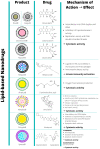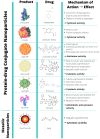Nano-Based Approved Pharmaceuticals for Cancer Treatment: Present and Future Challenges
- PMID: 35740909
- PMCID: PMC9221343
- DOI: 10.3390/biom12060784
Nano-Based Approved Pharmaceuticals for Cancer Treatment: Present and Future Challenges
Abstract
Cancer is one of the main causes of death worldwide. To date, and despite the advances in conventional treatment options, therapy in cancer is still far from optimal due to the non-specific systemic biodistribution of antitumor agents. The inadequate drug concentrations at the tumor site led to an increased incidence of multiple drug resistance and the appearance of many severe undesirable side effects. Nanotechnology, through the development of nanoscale-based pharmaceuticals, has emerged to provide new and innovative drugs to overcome these limitations. In this review, we provide an overview of the approved nanomedicine for cancer treatment and the rationale behind their designs and applications. We also highlight the new approaches that are currently under investigation and the perspectives and challenges for nanopharmaceuticals, focusing on the tumor microenvironment and tumor disseminate cells as the most attractive and effective strategies for cancer treatments.
Keywords: approved nanopharmaceuticals; cancer therapy; nanomedicine; nanotechnology; targeted therapy.
Conflict of interest statement
The authors declare no conflict of interest.
Figures



References
-
- Cooper G.M. The Development and Causes of Cancer. 2nd ed. Sinauer Associates; Sunderland, MA, USA: 2000. [(accessed on 1 January 2020)]. The Cell: A Molecular Approach. Available online: https://www.ncbi.nlm.nih.gov/books/NBK9963/
Publication types
MeSH terms
Substances
LinkOut - more resources
Full Text Sources
Medical

